This article features sections on the Sacred Ibis, the Northern Bald Ibis, and the Reunion Sacred Ibis. Enjoy!

Sacred Ibis: The Sacred Ibis (Threskiornis aethiopicus) is a species of wading bird of the ibis family, Threskiornithidae, which breeds in sub-Saharan Africa, SE Iraq and formerly in Egypt, where it was venerated and often mummified as a symbol of the god Thoth. It has also been introduced into France, Italy and Spain.
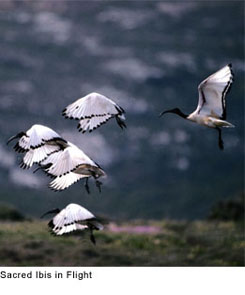 Just the Facts: The Sacred Ibis occurs in marshy wetlands and mudflats, both inland and on the coast. It will also visit cultivation and rubbish dumps. It feeds on various fish, frogs and other water creatures, as well as insects. Just the Facts: The Sacred Ibis occurs in marshy wetlands and mudflats, both inland and on the coast. It will also visit cultivation and rubbish dumps. It feeds on various fish, frogs and other water creatures, as well as insects.
An adult individual is 68 cm long with all-white body plumage apart from dark plumes on the rump. The bald head and neck, thick curved bill and legs are black. The white wings show a black rear border in flight. Sexes are similar, but juveniles have dirty white plumage, a smaller bill and some feathering on the neck.
Nest and Nestlings: The bird nests in tree colonies, often with other large wading birds such as herons. It builds a stick nest often in a Baobab.and lays 2-3 eggs.
Still Waters Run Deep: This bird is usually silent, but occasionally makes some croaking noises.
Let Me Introduce You To... The introduced and rapidly growing populations in southern Europe are seen as a potential problem, since these large predators can devastate breeding colonies of species such as terns. They also compete successfully for nest sites with Cattle and Little Egrets. The adaptable Ibises supplement their diet by feeding at rubbish tips, which helps them to survive the winter in these temperate regions.
Ibis in Danger: The Sacred Ibis is one of the species to which the Agreement on the Conservation of African-Eurasian Migratory Water birds (AEWA) applies.
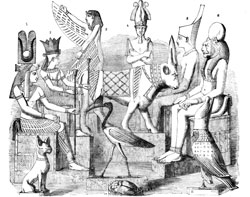 Sacred Ibis in Myth and Legend: Venerated and often mummified by Ancient Egyptians as a symbol of the god Thoth, the Ibis was according to Pliny the Elder also invoked against incursions of serpents. Sacred Ibis in Myth and Legend: Venerated and often mummified by Ancient Egyptians as a symbol of the god Thoth, the Ibis was according to Pliny the Elder also invoked against incursions of serpents.
It was also said that the flies that brought pestilence died immediately upon propitiatory sacrifices of this
bird (Pliny, Natural History Book X
Chapter 41).
-----------------------------------------------------------------------------------------------------------------------------
The Northern Bald Ibis: The Northern Bald Ibis, Hermit Ibis, or Waldrapp, Geronticus eremita, is a large bird found in barren semi-desert or rocky habitats, often but not always close to running water.
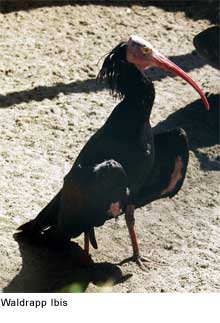 Weights and Measures: This is a large glossy black ibis, 70-80 cm long with a Weights and Measures: This is a large glossy black ibis, 70-80 cm long with a
120-135 cm wingspan. It has an unfeathered red face and head and a long curved red bill.
Nest and Nestlings: It breeds colonially
on cliffs in rocky deserts in the Middle East and Africa north of the Sahara, laying
2-3 eggs.
Don't Know What You've Got 'Till It's Gone... The Northern Bald Ibis was once very widespread across the Middle East, northern Africa and the European Alps.
It is migratory in parts of its range, but its wintering areas are poorly known; the Moroccan population is however
non-migratory.
Ibis in Danger: Like many species of ibis, this species is now officially critically endangered, with an estimated population in of 420 in the wild and about 1500 in captivity (2004). It retains only a foothold in Morocco, Turkey and Syria. There is a program ongoing to reintroduce the species into the wild in Austria, Spain and Italy.
The Northern Bald Ibis is one of the species to which the Agreement on the Conservation of African-Eurasian Migratory Water birds (AEWA) applies.
-----------------------------------------------------------------------------------------------------------------------------
The Reunion Sacred Ibis (extinct): The Réunion Sacred Ibis or Réunion Flightless Ibis (Threskiornis solitarius), is an extinct bird species that was native to the island of Réunion. It is probably the same bird discovered by Portuguese sailors there in 1613 and, until recently, assumed by biologists to be a member of the solitaire family and called the "Réunion Solitaire" (Raphus solitarius), classified as a relative of the Dodo.
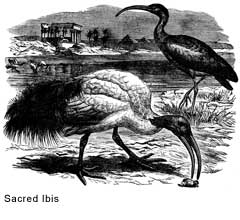 Classification Confusion: That bird was at various times classified as Victoriornis imperialis (the "Réunion Solitaire" or "White Dodo" of descriptions and paintings - the latter obviously show an albino dodo from Mauritius) and Borbonibis latipes (from the first ibis bones found, before a connection to the solitaire reports had been made). Classification Confusion: That bird was at various times classified as Victoriornis imperialis (the "Réunion Solitaire" or "White Dodo" of descriptions and paintings - the latter obviously show an albino dodo from Mauritius) and Borbonibis latipes (from the first ibis bones found, before a connection to the solitaire reports had been made).
The epithet solitarius derives from the Raphus solitarius description of Baron Edmund de Sélys-Longchamps in 1848, but the species' existence was not confirmed until the discovery of bones on Réunion in the late 20th century. The discovery that it actually was an ibis perfectly fits what the early travelers said about its plumage and habits. The confusion can be explained by the fact that solitaire was used by the writers of the descriptions as a descriptive term regarding to a birds' solitary habits, which the ibis happened to share with the Rodrigues Solitaire, but was interpreted by the scientists as an indication of a taxonomic relationship.
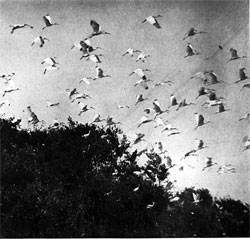 A Different Kind of Ibis: It had a white plumage, with black wingtips and tail, and a dark, naked head. Bill and legs were long, the former slim and slightly down curved. All in all, it looked much like a small Sacred Ibis with short wings. A Different Kind of Ibis: It had a white plumage, with black wingtips and tail, and a dark, naked head. Bill and legs were long, the former slim and slightly down curved. All in all, it looked much like a small Sacred Ibis with short wings.
Lonely Bird: The Réunion Sacred Ibis lived solitarily in deep
forests
near freshwater, where it fed on invertebrates like worms and crustaceans which it caught or dug out of the soil with its long beak.If threatened, it tried to get away
mainly by running, using its wings for assistance and to glide short
distances, especially downhill.
I Believe Ibis Can Fly: The vernacular name "Réunion Flightless Ibis" is misleading, since travelers' reports as well as bone measurements indicate that it was well on its way to flightlessness, but could still fly some distance after a running take-off.
Long Gone: The last account of the "Réunion Solitaire" was recorded in 1705, indicating that the species probably became extinct sometime early in that century.

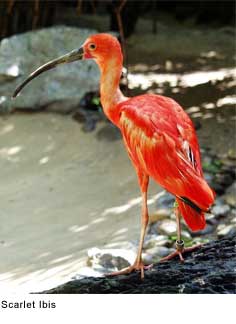
Feathered and Fearless: According to folklore, the ibis is the last form of wildlife to take shelter prior to a hurricane and the first to reappear after the storm passes.
What's in a Name? The name ibis comes from Greek borrowed from Ancient Egyptian hîb.
Classification: The ibis family is one of the families in the order Ciconiiformes, which also includes other wading
bird families:
- Genus Threskiornis
- Sacred Ibis, Threskiornis aethiopicus
- Madagascar Sacred Ibis, Threskiornis bernieri
- Réunion Sacred Ibis, Threskiornis solitarius extinct
- Black-headed Ibis, Threskiornis melanocephalus
- Australian White Ibis, Threskiornis molucca
- Straw-necked Ibis, Threskiornis spinicollis
- Genus Pseudibis
- Indian Black Ibis, Pseudibis papillosa
- White-shouldered Ibis, Pseudibis davisoni
- Genus Thaumatibis
- Giant Ibis, Thaumatibis gigante
- Genus Geronticus
- Northern Bald Ibis, Geronticus eremita
- Southern Bald Ibis, Geronticus calvus
- Genus Nipponia
- Japanese Crested Ibis, Nipponia nippon
- Genus Bostrychia
- Olive Ibis, Bostrychia olivacea
- Dwarf Olive Ibis, Bostrychia bocagei
- Spot-breasted Ibis, Bostrychia rara
- Hadada Ibis, Bostrychia hagedash
- Wattled Ibis, Bostrychia carunculata
- Genus Theristicus
- Plumbeous Ibis, Theristicus caerulescens
- Buff-necked Ibis, Theristicus caudatus
- Andean Ibis, Theristicus branickii
- Black-faced Ibis, Theristicus melanopis
- Genus Cercibis
- Sharp-tailed Ibis, Cercibis oxycerca
- Genus Mesembrinibis
- Green Ibis, Mesembrinibis cayennensis
- Genus Phimosus
- Whispering Ibis, Phimosus infuscatus
- Genus Eudocimus
- American White Ibis, Eudocimus albus
- Scarlet Ibis, Eudocimus ruber
- Genus Plegadis
- Glossy Ibis, Plegadis falcinellus
- White-faced Ibis, Plegadis chihi
- Puna Ibis, Plegadis ridgwayi
- Genus Lophotibis
- Madagascar Crested Ibis, Lophotibis cristata
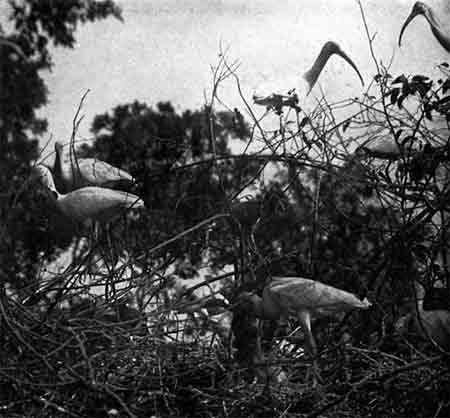
All text is available under the terms
of the GNU Free Documentation License
|